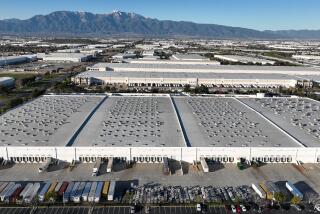‘Influence Machine’ reveals how U.S. Chamber of Commerce oils the engine of politics
- Share via
Nearly 50 years ago, California Assembly Speaker Jesse Unruh famously compared campaign cash to mother’s milk. Though money and influence have always shaped American politics, the nature of that power is changing. Driven by the rise of political action committees and a Supreme Court that has conflated campaign spending with free speech, money has become ever more essential to the acquisition and maintenance of political influence, and both the sources and use of that influence are becoming more difficult to discern.
That has created huge sources of unaccountable power, and Alyssa Katz, in this important and probing work, examines one of the oldest, most opaque and most significant.
“The Influence Machine: The U.S. Chamber of Commerce and the Corporate Capture of American Life” is a valuable and a sobering contribution to the study of power in American society. Katz, a talented investigative reporter, presents a methodical, if not entirely persuasive, case for the idea that the chamber is, as she says at the outset of her book, “the single most influential organization in American politics” other than the political parties themselves.
Summer reading guide: The 136 books you’ll want to read
Katz has assembled a work of synthesis and insight. She carefully marshals the historical record and supplements it with interviews and documents that reveal the chamber’s aggressive campaign spending and its relentless determination to punish its real and imagined enemies. Over the years, the chamber has fought against consumer protections, environmental regulations, tobacco taxes, regulation of the financial industry, attempts to extend health insurance to more Americans and, above all, taxes.
The chamber’s methods are neither novel nor subtle. As Katz demonstrates in case after case, big business gives money to the chamber, which spends it on skewed studies, alarmist ads and misleading political campaigns — as well as more straightforward and reputable efforts. If there’s blowback, the chamber absorbs it, allowing its member companies to hide behind its skirts. That’s especially helpful for companies and industries with dodgy reputations: If an oil company wants to off a candidate who supports reductions of greenhouse gas emissions, far better to have the chamber take the lead.
That makes the chamber a valuable advocate, and the chamber has used its influence to defend its members and to build its own stature. “My goal is simple” chamber head Tom Donohue said in 1998, “to build the biggest gorilla in this town — the most aggressive and vigorous business advocate our nation has ever seen.”
Katz carefully charts the chamber’s growth and its influence across elections and political battles over decades. The chamber has, she argues, effectively countered the influence of labor unions and contributed to the widening economic divide in American society. Those points are made forcefully and backed up impressively.
I’m less convinced, however, that Katz proves her hypothesis: that the chamber is the single most influential actor in this sea of interests. It’s not provable, of course, that any group is the “most influential,” and Katz’s own narrative points out the many instances in which the chamber has fought and lost. It tried to beat down a tax increase under Ronald Reagan — and lost. It protested Bill Clinton’s plan to sue tobacco companies to recover Medicare costs associated with smoking — and lost. It fought against the Affordable Care Act —– and lost. Yes, it often wins, but its record is decidedly mixed.
So is the chamber more powerful than, say, the National Rifle Assn. or the AFL-CIO? Or the Koch brothers, Karl Rove or Apple? Again, there’s no real metric to measure that. I left her book persuaded that the chamber is a powerful actor and has been for a long time but also that it’s one of many such influential organizations and that it tends to prevail when its ambitions harmonize with those in power or with other influential interest groups.
There’s nothing really wrong with that: The chamber is looking out for the interests of its members and acting vigorously in their defense. Blaming the chamber for being good at its work is a little like blaming a shark for biting.
Katz’s book may rest on an unprovable premise, but that doesn’t detract from its fresh and important insight into how power works in today’s politics. That’s true whether the chamber is the most influential organization in American politics or merely one of several such organizations.
Its shrewd use of money, its blend of blandishment, bluster and threat, its cover for unsavory interests such as Big Tobacco or Big Oil make the chamber a force that is shaping the political choices of Americans. Katz shows how.
The Influence Machine: The U.S. Chamber of Commerce and the Corporate Capture of American Life
Alyssa Katz
Spiegel & Grau: 254 pp., $28
Newton, a longtime editor and columnist for the Los Angeles Times, is editor in chief of Blueprint magazine and the author or co-author of three books of American history and biography.
More to Read
Sign up for our Book Club newsletter
Get the latest news, events and more from the Los Angeles Times Book Club, and help us get L.A. reading and talking.
You may occasionally receive promotional content from the Los Angeles Times.








